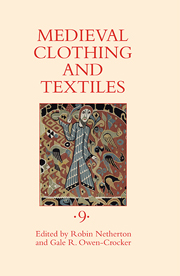Book contents
- Frontmatter
- Contents
- Illustrations
- Tables
- Contributors
- Preface
- 1 Bridal Gifts in Medieval Bari
- 2 The Marriage of the Year (1028)
- 3 Clothing as Currency in Pre-Norman Ireland?
- 4 Cistercian Clothing and Its Production at Beaulieu Abbey, 1269–70
- 5 Clothing and Textile Materials in Medieval Sweden and Norway
- 6 The Iconography of Dagged Clothing and Its Reception by Moralist Writers
- 7 Domestic Painted Cloths in Sixteenth-Century England: Imagery, Placement, and Ownership
- Recent Books of Interest
- Contents of Previous Volumes
4 - Cistercian Clothing and Its Production at Beaulieu Abbey, 1269–70
Published online by Cambridge University Press: 05 July 2013
- Frontmatter
- Contents
- Illustrations
- Tables
- Contributors
- Preface
- 1 Bridal Gifts in Medieval Bari
- 2 The Marriage of the Year (1028)
- 3 Clothing as Currency in Pre-Norman Ireland?
- 4 Cistercian Clothing and Its Production at Beaulieu Abbey, 1269–70
- 5 Clothing and Textile Materials in Medieval Sweden and Norway
- 6 The Iconography of Dagged Clothing and Its Reception by Moralist Writers
- 7 Domestic Painted Cloths in Sixteenth-Century England: Imagery, Placement, and Ownership
- Recent Books of Interest
- Contents of Previous Volumes
Summary
The Latin account of the keeper of the wardrobe (vestiarius) for the Cistercian monastery at Beaulieu, Hampshire, in 1269–70 contains important English woollen textile production cost information for the later Middle Ages, and considerable detail concerning clothing for the abbey's monks and lay brothers. The following analysis of Cistercian clothing derived from this account complements Barbara Harvey's study of Benedictine monks' clothing at Westminster Abbey in the fourteenth to sixteenth centuries. The only other late-medieval cost data on English woollen cloth production so far discovered have been the few scraps of production information at Westminster Abbey's manor of Laleham, Middlesex, from 1294–95 and the costs derived from a claim made in the Colchester court of pleas by a weaver, William Okle, in 1388. For broadcloth production costs, English economic historians have had to rely on continental records or isolated costings for individual processes. This 1269–70 set of accounts predates the voluminous cloth cost information in the Datini archives at Prato near Florence by more than a century.
THE CISTERCIANS
The Cistercian order was founded in the late eleventh century by a Benedictine abbot who wished to follow the Rule of St. Benedict literally, setting up a new monastic order at Cîteaux in France in 1098, substituting the undyed, white/grey/brown habit—symbolic of humility and repentence—for the Benedictine black. The Rule emphasised the simple life of work, love, prayer, and self-denial.
- Type
- Chapter
- Information
- Medieval Clothing and Textiles 9 , pp. 73 - 96Publisher: Boydell & BrewerPrint publication year: 2013



